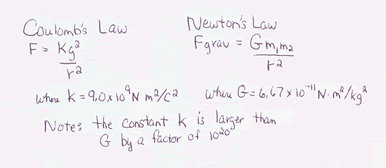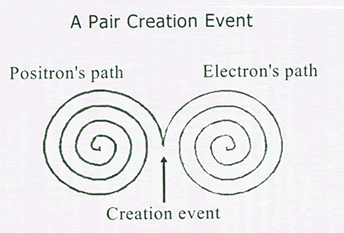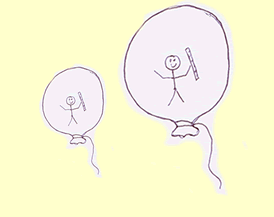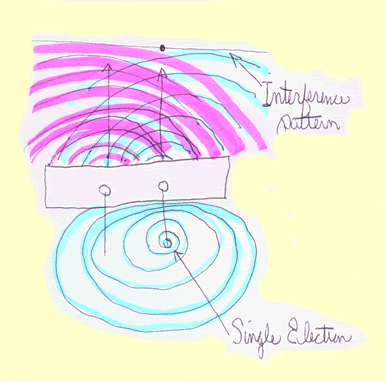|
TIME We do not know time. She clothes herself in the stuff of dreams and dances to an unfamiliar melody. Men believe she has but one face but in reality she is a diamond with many facets. |
|
The universe is a time field. The ether is “time” itself. Space expands or contracts according to how much time it contains. We cannot see this change in space; we can only observe its effects. What is the difference between a changing space and that one in which we live? Space is determined by how fast or slow time is passing. If time slows down… space appears to shrink but actually more of it is being squeezed into a smaller space.. An object traveling in the vicinity of slower time speeds up because it must maintain its own rate of passing time. To us space and distance always appear the same unless we accelerate. In that case we are slowing down the passing of time ourselves and thus creating an artificial gravity. Although we ourselves shrink, we travel farther in the same amount of time and do not realize that the passing of time has slowed down. Space can be likened to a string of pearls. Space to us appears to be the string in that it always stays the same length, the same dimension. But space is more like the pearls. It grows and shrinks and the only way we know it is doing so is by observing its effects. Is there an example in our world where something changes and causes different effects? Yes, one substance can appear as different forms depending on its changing density. An example is water. We can walk on ice, swim in water, or pass through steam. Density can even appear to us as a force. Duck Weed on a pond contains a heel and toe that align their self due to the forces of surface tension and water density distribution. Seen from afar one can observe an imaginary force lining up the Duck Weed. It is interesting to note that density determines the space something occupies. Density through pressure can even cause temperatures to rise. Effects of a changing space are electricity, gravity, and magnetism. They are one force. Because time slowing down or speeding up affects the geometry of space we can mathematically observe the symmetry between electricity and gravity. Experiments with Coulomb’s law show that the force between electrical charges is proportional to the product of the charges and inversely proportional to the square of the distance between them. By substituting masses for electrical charges and by using a different universal constant we have Newton’s equation for a gravitational field. Why does the electrical force appear to be so much more powerful then the gravitational force if they are the same thing? Because of distance. Time slowing down in the vicinity of a particle is EXTREME and warps space an EXTREME amount. It is an inverse ratio thing, the larger the distance, the less the effect. "Before I began the study of electricity I resolved to read no mathematics on the subject till I had first read through Faraday’s Experimental Researches in Electricity. I was aware that there was supposed to be a difference between Faraday’s way of conceiving phenomena and that of the mathematicians, so that neither he nor they were satisfied with each other’s language. I had also the conviction that this discrepancy did not arise from either party being wrong. As I proceeded with the study of Faraday, I perceived that his method of conceiving the phenomena was also a mathematical one, though not exhibited in the conventional form of mathematical symbols. I also found that these methods were capable of being expressed in the ordinary mathematical forms, and thus compared with those of the professed mathematicians. For instance, Faraday, in his mind’s eye, saw lines of force traversing all space where the mathematicians saw centers of force attracting at a distance: Faraday sought the seat of the phenomena in real actions going on in the medium, they were satisfied that they had found it in the power of action at a distance impressed on the electric fluids." 1. "Thanks to Einstein, magnetism is nowadays understood to be simply a relativistic version of the electric force - an effect of charges in motion." 2. Einstein saw the universe as a space/time continuum and called time a 4th dimension. There would be no problem describing space in this way if time passed at only one rate. But time slows down and space shrinks, time speeds up and space expands. No longer do we have 4 dimensions but in fact we have an infinite number of dimensions because time itself at any point in space can pass at an infinite number of rates. Let us examine this thing called “time”. In the book, Einstein’s Universe this statement is made: "Time may in some deep sense be energy and nothing else." 3. Timetrics: Energy is time and nothing else and what we call matter is simply the amount of time contained in a certain space. Time never stops and appears in two forms that are exclusionary. Motion: as in an electromagnetic wave OR Time Passing: matter Time in motion follows the contours of space dictated by the rate at which time passes. Time passing appears as matter. We call time in motion an electromagnetic wave (always traveling approximately 186,000,000 mi/hr in the vacuum of empty space). Time in motion carries what is now called energy, the higher the wave frequency, the higher the energy is. But energy IS time so an electromagnetic wave is actually carrying an amount of time. The higher the wave frequency, the more time is carried by the wave. How does time in motion get turned into time passing or what appears to us as matter? Let us combine what both Isaac Newton and Albert Einstein said. Newton said that once an object is set in motion it follows a straight path forever unless a force is acted upon it. An object following a curved path is accelerating and thus has a force acted upon it. Einstein said that light must always travel at the same speed no matter what. (Ignoring different densities for the moment) What happens when an electromagnetic wave (time wave) travels in a curved path? It must maintain the same speed and yet we know in a curved path it must accelerate. Ahhhhh, the rate of the passing of time to the rescue. Time slows down, space changes and the time wave continues to go at the same speed without accelerating. So what is matter? Sub atomic particles are standing time waves- nothing more. Time slows down at an increasing rate toward the center of any particle in order to accommodate the speed of the time wave. Larger atoms with greater numbers of electrons contain more overlapping time waves. This added time content causes space to shrink for an atom with more than one electron. "Another symptom of the curvature of space is that the surface area of a massive body is less than you would deduce by measuring its radius and applying the Euclidean formula (4 pi r squared). In other words the radius is too great for the area, and the ‘excess radius’ is proportional to the mass of the object. In the case of the Earth the excess radius is about six hundredths of an inch, which means that its surface area is about sixty acres less that you would expect. For the Sun, the excess radius is about 500 yards and the ‘missing’ area is about 3.4 million square miles- roughly the area of the USA." 4. What if a time wave were to travel in a curved path exactly opposite to another wave? Does time have a direction in space? Can time flowing in one direction cancel time flowing in the opposite direction if they were to meet? "From two gamma-rays with energy equivalent to twice the mass of the electron you can make an electron and a positron (anti-electron). Anti-particles are very like the corresponding particles but their opposite- so exactly opposite that when a particle meets its anti-particle they annihilate one another and disappear from the universe. All that remains is a ‘puff’ of gamma-rays- a reversal of the process of creation." 5. So let us clarify a little bit. An ocean wave does not move individual water molecules great distances but instead moves energy thru the water by moving water molecules up and down. A moving time wave does not permanently change the rate at which time passes but temporarily changes it in order to move through space. A standing time wave permanently changes the rate at which time passes and appears as matter. The more time contained in a space, the more time slows down, and thus the more mass there appears to be. Does time really pass at different rates? "Time should run slower in regions where gravity (i.e., space-time curvature) is stronger. A simplified explanation is that light loses energy “climbing” away from a gravitating mass. Light can’t slow down, but the frequency of the light waves is reduced. To an observer looking toward a region of strong gravity, the effect is to see time running slower in that region. This is called gravitational time dilation. In a very sensitive experiment at Harvard in 1960, physicists used nuclear radiation to verify gravitational time dilation, effectively measuring differences in the rate of time over a distance of a mere 74 feet. Gravitational time dilation is also verified by sensitive measurements of the frequency of radiation emitted by the Sun. Even though curvature of space-time in Earth’s vicinity is slight, the Global Positioning System (GPS) is so precise that its position determinations would be off by a significant fraction of a mile if gravitational time dilation were not taken into account." 6. "Experiments with subatomic particles called muons dramatically confirm that time dilation really occurs. These particles are produced in the upper atmosphere and travel downward at nearly the speed of light. But they’re radioactive, and they decay in such a short time that they shouldn’t last long enough to make it to the ground. Yet they do- showing that time runs slower in the muons’ frame of reference by just the amount expected from time dilation." 7. So what if changing space shrinks in the vicinity of slower time, how come I can’t see or measure it? Picture a balloon with yourself drawn on that balloon and holding a ruler. If the balloon gets blown up, you get blown up along with your ruler so there is no way to determine if space has changed…expanded or shrunk. According to Einstein when an object speeds up and creates for itself artificial gravity- its length shrinks. The object can travel a further distance in the same amount of time because its passing of time has slowed down. A light wave (or time wave) entering a field of gravity cannot act like a piece of matter that speeds up to keep its passing rate of time static. This is because a light or time wave cannot travel faster then the well known speed for light. A light wave will temporarily add space’s passage of time rate to its own time content by acquiring a higher frequency at the same speed. But this is only temporary. When a light wave leaves a field of gravity the opposite occurs and the light wave temporarily contains less time and a lower frequency. If the speed of light cannot speed up then why does it slow down in denser materials like water and glass? In this case the landscape of space in the material has been permanently changed by a more extreme change in time rate and time itself is dense. In order to navigate the space the light wave will slow down, or change its frequency in order to accommodate the landscape. "There are real crystals through which light travels at different speeds in different directions. Accordingly time also passes more rapidly in one direction that in another." 8. OK, so now lets see if we can answer some quantum mysteries and make other observations with the theory of Timetrics. COMPLEMENTARITY- wave-particle duality of light "Complementarity is the concept developed by Niels Bohr to explain the wave-particle duality of light. No one has thought of a better one yet. Wave-like characteristics and particle-like characteristics, the theory goes, are mutually exclusive, or complementary aspects of light. Although one of them always excludes the other, both of them are necessary to understand light. One of them always excludes the other because light, or anything else, cannot be both wave-like and particle-like at the same time. Individual events are always particle-like; wave behavior is detected as a statistical pattern, i.e., interference. However, in the words of Paul Dirac (another founder of quantum mechanics) even a single subatomic particle “interferes with itself.” How a single subatomic particle, like an electron, for example, can “interfere with itself” is the basic quantum paradox. " 9. Timetrics All particles are standing waves. Space is distorted less and less further from the wave center but distorted nonetheless. A moving particle is a moving standing wave and thus space is distorted not only at the center of the wave but further out. These distortions will travel through holes and cause the particle to interfere with itself even though it is not at the center of the wave. The Pauli Exclusion Principle In a closed system, no two electrons can occupy the same state. (Actually, protons and neutrons obey the same principle, while photons do not.) Why is this? If particles and photons are the same thing (i.e., waves) then how come multiple photons can occupy the same spot while particles cannot? Photons (light or linear time waves) only temporarily disturb the time field as they move through. Thus many can pass through the same space at one time. Particles are standing circular time waves and permanently change the time field by changing passing time. When this happens the direction of the spinning standing wave causes the particle to become attractive or repulsive to other particles. In essence light waves and particles are the same thing. It is just that one is a linear wave moving only through space and temporarily disturbing the time field and the second is a circular standing wave warping space and acquiring a positive or negative attraction due to the spin of the wave. Standing waves (particles) also move through time. Motion waves only carry time information and do not move through time. The Uncertainty Principle "When we observe something—an atom, for example—we shoot electromagnetic radiation at it. The radiation then reflects off the atom and returns to our detecting device (our eyes, a microscope, or other apparatus). However, when the photons hit the particle being studied, it disturbs the position of the particle. The more accurately we try to observe the particle, using higher energy radiation, the more we disturb the particle’s position. Using this type of example as a guide, Werner Heisenberg formulated a law he called the uncertainty principle, which states that the uncertainty in the position of a particle multiplied by the uncertainty in its velocity can never be smaller than a constant (specifically, Planck’s constant over 4 pi). Therefore, the more precisely we know a particle’s position, the more imprecisely its velocity is. The uncertainty principle seems to be a fundamental characteristic of our universe, and numerous experiments have confirmed its effects. An experiment with a light source confirmed that Electromagnetic waves interact with each other. For instance, if the crest of one wave matches the crest of another, the waves are “added,” or amplified. An experiment with a light source confirmed that Electromagnetic radiation could be thought of as a wave. A screen with two tiny slits was mounted in front of a light source. Another screen was mounted behind the first, so that light passing through the slits would show up and be seen. When the light waves passed through the slits, they interacted (or interfered) with each other, producing a series of dark and light bars as the waves sometimes cancel and sometimes amplify each other. When the experiment was repeated using electrons instead of light waves, the interference pattern remained! Even when one electron at a time was sent through the screen, the pattern still appeared: the electron must have passed through both slits and interfered with itself! The electron was behaving as a wave instead of a particle! Because particles such as electrons can now be thought of as waves, the uncertainty principle now seems more reasonable, because the “position” of a wave cannot be determined precisely. The strange particle/wave duality is a hallmark of quantum mechanics. " 10. Compton Scattering "In quantum mechanics, the Compton effect is the increase in wavelength (decrease in energy), which occurs when X-ray (or gamma ray) photons interact with electrons in a material. The amount the wavelength is increased by is called the Compton shift. Compton’s experiment became the ultimate observation that convinced all physicists that light could behave as a stream of particles whose energy is proportional to the frequency. Because the photons have such high energy, the interaction results in the electron being given enough energy to be completely ejected from its atom, and a photon containing the remaining energy being emitted in a different direction for the original, so that the overall momentum of the system is conserved. (If the photon still has enough energy, the process may be repeated.) Because of the overall reduction in energy of the photon, there is a corresponding increase in its wavelength. Thus overall there is a slight ‘reddening’ and scattering of the photons as they pass through the material. This scattering is known as Compton Scattering. The effect is important in scientific terms because it demonstrates that light cannot be explained purely as a wave phenomenon. Thomson scattering, the classical theory of charged particles scattered by an electromagnetic wave, cannot explain any shift in wavelength. Light must behave as if it consists of particles in order to explain the Compton scattering." 11. Timetrics Is a photon a wave or a particle? A photon is a wave, which carries a discrete amount of time. It is this discreteness, which makes it appear as a particle. The wave can transfer part of its time (energy) to an electron. Thus the wave will have a longer wavelength (less energy) and the electron as a standing wave with added time acquires additional energy of motion. Time slows down for the electron so it travels faster. Heat "When something gets warmer, its energy content goes up. We call that kind of energy internal energy. There are a lot of measurable properties of things that change when objects heat up. A liquid or a solid expands when heated. The pressure in a gas increases. Electrical resistance changes. Any of these properties may be useful in defining what we mean by temperature." 12. The standard explanation for heat is that as energy gets added to an object, its molecules get excited and speed up. Timetrics If you add energy to something as either heat or light you are adding time. (Remember matter and energy are the amount of time that a thing contains) When you add time… time slows down. Consequently particles speed up because their passing rate of time has slowed down. When enough time is added, other atoms and molecules are affected also by the slowing down of time in their vicinity and they will speed up also even if they have not yet been hit by a photon.
"The tides are due to the differences in gravity at different distances from the moon. When a Sailor in the Atlantic sees the moon overhead, he is 8000 miles nearer to the Moon than his opposite number in the western Pacific, on the far side of the Earth. The world’s oceans are thus exploring different regions of the Moon’s sphere of warped space-time. The overall effect is to distend the sphere of the sea level into an egg-shaped (ellipsoidal) form, pointing at the moon. The Moon itself has a frozen shape like that and as a result, the tidal effect of the Earth on the Moon keeps the same ‘end’ of the Moon pointing at us always. In the curved space near a massive body, space is destroyed: the area and volume of a sphere are less than you would expect from the radius. Accordingly, while an object falling towards the massive body is stretched lengthways by the tides it is also squeezed from the sides to reduce its volume and make it fit into the shrunken space." 13. TimetricsThe common explanation for the tides is that the oceans tend to ‘fall’ towards the gravity of the Moon. It is more than that. Think of water. It always finds the lowest level. When the moon is overhead this lowest level changes and becomes bulged towards the moon. Why is that? Time passing on the earth in the vicinity of the moon becomes changed by the passing time of the moon. We know that space is distorted when time passes at a different rate. In this case the oceans rush in to fill the new volume at the new sea level. This distortion of space follows the moon around taking the oceans with it. If one were to measure the rate at which time passes when the moon is directly overhead and then at the same location measure the rate at which time passes when the moon is on the opposite side of the earth, he will find that the two do not agree. |
|
Summary So again we will clarify. Time does not just slow down in a gravitational field. The slowing down of time is what a gravitational field is. Einstein said that the Universe is a Space/Time continuum and it is…….. That is all it is. The universe is a time field. The ether is “time” itself. There is no matter or particles except for the disturbance in the time field. The information of time can be carried through the field by temporarily disturbing it. When this information becomes caught in a circular or standing wave it permanently changes the time field and appears as matter. Matter travels through time. The more matter, the more space is changed, the more time content there is, the more the passing rate of time slows. Add energy (time) to matter and matter gains more mass (time). So if the Universe is a time field and everything is essentially made up of time is anything solid or real? Yes. Because it is all relative. Everything dances to the rhythm of time and even colors are determined by differing frequencies. Man himself is made of time and he looks out upon the differing time densities and sees a “material universe.”
|
|
References 1. Page viii A Treatise on Electricity & Magnetism Written by James Clerk Maxwell regarding Michael Faraday 2. Page 30 Einstein’s Universe 4. Page 85 Einstein’s Universe 5. Page 40 Einstein’s Universe 6. Page 80 Einstein’s Relativity & the Quantum Revolution 7. Page 33 Einstein’s Relativity & the Quantum Revolution 8. Page 94 Einstein’s Universe 9. P 103 The Dancing Wu Li Masters 10. Net Equation: Your Online Source for Chemistry Solutions 11. Wikipedia, the free encyclopedia 12. Page 139 Physics The Easy Way 13. Page 119 Einsteins Universe |






